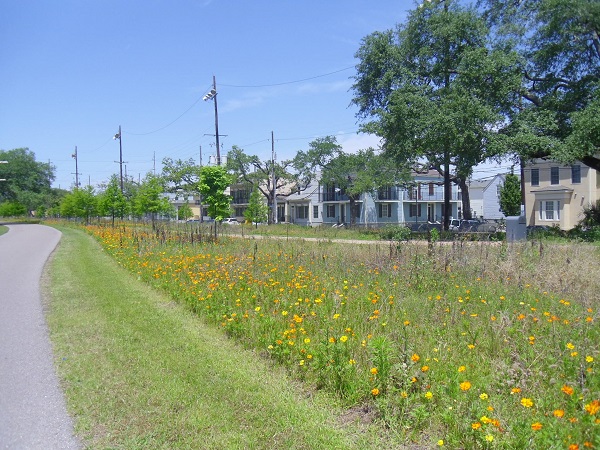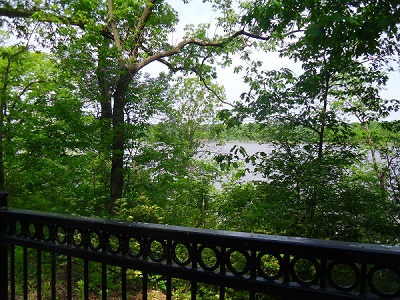| Back to Back Issues Page |
 |
|
Useful Community Plus January 23, 2020 |
Feature: Greenway Planning. Also in This Issue: Most Popular with Readers in 2019Since we are keen on actually being helpful to our readers, every year we tally the most popular pages on our website. Last year you enjoyed seeing our results. (Of course this is a little tongue in cheek, because much depends on the whims of search engines and availability of other information.) But just for fun, the top 10 pages on our site last year were:Cleaning Up Your Neighborhood Park How Far Can the City Go in Forcing Citizens to Obey Codes The ever-popular How to
Oppose a Rezoning Definition of Community Development It's Time to Plan a Greenway Let's start off the new year with thinking about why a greenway might enhance your community. We're considering features associated with a linear walkway or bicycle trail through a mostly narrow green space as a greenway. Many follow streams, bayous and other storm drainage facilities, lakes, or other waterfronts.
Let's start off the new year with thinking about why a greenway might enhance your community. We're considering features associated with a linear walkway or bicycle trail through a mostly narrow green space as a greenway. Many follow streams, bayous and other storm drainage facilities, lakes, or other waterfronts.
Even though these might be only the width of a trail plus a little shoulder area for maintenance, they also can widen out to incorporate parks, conservation areas, gardens, and other landscape features. They could be at grade with the adjoining landscape, but also might include long or short underpasses or elevated sections. Greenways may be elaborate affairs incorporating a multitude of cultural, natural, and historical resources, while offering play and gathering spaces for young and old. At the simplest level, they may follow a nearly ready-made existing foot trail or take advantage of unused paved surface. Some towns and cities call their bicycle lanes greenways, but we prefer to think of those as an essential element of the transportation system. The potential community advantages of new or enhanced greenways encompass environmental, social, transportation, hazard mitigation, and economic benefits. Let's consider these one at a time. 1. Environmental benefits. Because of the landscape scale of most greenways, they offer the mental health benefits of green space combined with increased wildlife and bird habitat, carbon sequestration, and potential for reduced air pollution, resulting both from replacing short automobile trips with bicycle and walking trips and from absorption of auto emissions. 2. Social benefits. Their linear nature makes greenways ideal vehicles for bridging social divides across daunting geographic barriers such as major streets and across neighborhoods, classes, ethnicities, and political boundaries. In addition, greenways can increase contact among the generations and generate the random social encounters that fuel a healthy democracy. Public health benefits such as decreased obesity and more exercise are obvious as well. Recreation for all ages and outdoor play for youngsters enhance mental and physical health, and make communities more attractive to residents and businesses. 3. Transportation benefits. The 2018 National Household Travel Survey found that 35 percent of all vehicle trips in the U.S. were less than two miles long. Converting a meaningful percentage of those trips to walking, bicycle, or scooter trips means less traffic congestion, lower personal transportation costs, less public debt for capital improvements, and more equitable transportation options for the young, the old, and the lower income segments of the population. While these statistics vary in other countries, benefits still amount to important savings. 4. Hazard mitigation benefits. Widening effective floodways through building greenways in low-lying areas can reduce flooding downstream and provide attractive and socially beneficial uses for buyout land. As climate change action accelerates, low-lying coastal areas also can reuse relocation lands as greenways that widen coastal access to create new recreational opportunities. 5. Economic benefits. While some business leaders and developers continue to be threatened by the increasing popularity of greenway development, the reality is that a well-executed greenway can create a new amenity to support dense residential areas and generate new business opportunities such as restaurants, refreshment stands, bicycle shops, and other small shops. Major greenways forming a new axis through a city can spur redevelopment, foster entrepreneurship, and enhance innovation centers. Greenway planning is similar to many other types of specialized city plans. To get started, see our community planning process overview. Here we offer just a few tips that are somewhat distinctive to greenway planning. 1. If you are working with a community with few or no existing greenways, you will have to first explain the term and show numerous examples. The upside is that photos quickly convey an array of greenway possibilities. If you have little to no idea of where and what a greenway should be, you can still begin the planning process by asking the public for ideas; in this case, just expect the process to take longer than usual. 2. Make sure your planning team includes imaginative landscape architects, since careful deployment of trees, plantings, and water features is quite important in greenway planning. 3. While we are very supportive of including children and teens in all aspects of planning, they are particularly likely to grasp greenway planning concepts, make important contributions to the process, and suggest recreational draws that adults may not even be aware of. 4. Any existing advocacy groups for bicycling and walking must be given important roles in the planning process, and yet not allowed to dominate it. These groups often grow impatient with any emphasis on historic or cultural features, ecological services, business development, or playgrounds and gathering spaces that emerge, so be sure to let them know you are planning more than a facility to maximize their particular interest. 5. Opportunities for connecting disparate social networks are particularly abundant in greenway planning. The short-term disadvantage of this fact is that building a coalition to support the planning process may take a bit longer than usual. 6. Understand that in many cities and towns, there is no established funding mechanism for greenways. Often the funding comes from a variety of sources, so the implementation section of the plan must receive special attention if participants are not to be disappointed. Include representatives of potential funding streams early and often during the planning process. To help you begin, check out our articles on bikeable and walkable communities. In the next article, we link to a new list of pages applicable to greenway planning. The Virginia Department of Conservation and Recreation provides a useful Greenways and Trails Toolbox. We also recommend the citizens guide to creating greenways from the State of Massachusetts.
Three New Year's Tips for Getting More from the Website1. Because community development is so cross-disciplinary, you could miss some important pages relevant to an issue you are considering. Find links to lists for different types of planning near the top of the sitemap page.In honor of this month's feature story, we added a list of possible pages for greenway planning. Also on the sitemap, you'll find downloadable lists of relevant pages for Neighborhoods, Distressed Neighborhoods, Planning Commissioners, Rural Communities, Suburban Communities, Business Districts, Local Government Officials, International Developing Nations, Regional Issues, and Working with Lower-Income Populations. 2. This is a great time of year to kick off a neighborhood organizing project. Your first step could be purchasing our inexpensive e-book on the subject. The link gives a description, contents, and directions for purchase. 3. For good reason, one of our favorite community organizing activities is the neighborhood park cleanup. We have a fair number of specifics on our cleaning up your neighborhood park page. Of course the principles can be extrapolated to a spring cleanup of a large regional park as well. It's time to plan and schedule this now. Bonus: As usual we have added some new pages this month, this time only answering reader questions. Check out: Restrictions not listed in deeds for last 30 years What happens when you unknowingly purchase a rental home with a deed restriction How to get more fixed-income housing built, perfect for affordable housing citizen advocates What if a management company hired by the HOA does not respond |
| Back to Back Issues Page |
